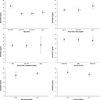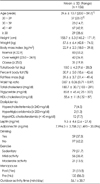Abstract
Purpose
Vitamin D status is associated with several chronic diseases related to obesity. In this study, we evaluate the nutritional status of vitamin D and its relation to obesity indices in Korean women.
Methods
A total of 156 healthy women participated. Vitamin D status (serum 25-OH-vitamin D3 level) and obesity indices (body mass index, body fat mass, waist-hip ratio, and body fat percentage etc.) and serum lipid profiles and serum adipokine (leptin and adiponectin) levels were analyzed.
Results
The 25(OH)D3 level showed an extremely skewed distribution from 4.1 ng/ml to 24.4 ng/ml and mean 25(OH)D3 level was 9.0 ± 4.0 ng/ml. With cut-off level for vitamin D deficiency (< 12.0 ng/ml), insufficiency (12-19.9 ng/ml) and sufficiency (≥ 20 ng/ml), 77.6%, 19.2%, and 3.2% of subjects showed vitamin D deficiency, insufficiency, and sufficiency status, respectively. The 25(OH)D3 level showed positive correlation with weight (r = 0.2461, p < 0.01), body mass index (r = 0.2913, p < 0.001), body fat contents (r = 0.1691, p < 0.05), fat free mass (r = 0.2330, p < 0.01), and waist hip ratio (r = 0.1749, p < 0.05) after adjusted by age. The 25(OH)D3 level showed no significant correlation with serum lipid profiles and adipokine levels.
Figures and Tables
 | Fig. 1Serum 25(OH)D3 levels by general characteristics. Symbol with different superscripts are significantly different by ANOVA with post hoc test of Scheffe's method (p < 0.05). |
References
1. Parikh SJ, Edelman M, Uwaifo GI, Freedman RJ, Semega-Janneh M, Reynolds J, Yanovski JA. The relationship between obesity and serum 1,25-dihydroxy vitamin D concentrations in healthy adults. J Clin Endocrinol Metab. 2004; 89(3):1196–1199.

2. Snijder MB, van Dam RM, Visser M, Deeg DJ, Dekker JM, Bouter LM, Seidell JC, Lips P. Adiposity in relation to vitamin D status and parathyroid hormone levels: a population-based study in older men and women. J Clin Endocrinol Metab. 2005; 90(7):4119–4123.

3. Ford ES, Ajani UA, McGuire LC, Liu S. Concentrations of serum vitamin D and the metabolic syndrome among U.S. adults. Diabetes Care. 2005; 28(5):1228–1230.

5. Chowdhury R, Stevens S, Ward H, Chowdhury S, Sajjad A, Franco OH. Circulating vitamin D, calcium and risk of cerebrovascular disease: a systematic review and meta-analysis. Eur J Epidemiol. 2012; 27(8):581–591.

6. Abrahamsen B, Masud T, Avenell A, Anderson F, Meyer HE, Cooper C, Smith H, LaCroix AZ, Torgerson D, Johansen A, Jackson R, Rejnmark L, Wactawski-Wende J, Brixen K, Mosekilde L, Robbins JA, Francis RM. DIPART. Vitamin D Individual Patient Analysis of Randomized Trials) Group. Patient level pooled analysis of 68 500 patients from seven major vitamin D fracture trials in US and Europe. BMJ. 2010; 340:b5463.
7. Holick MF. Vitamin D status: measurement, interpretation, and clinical application. Ann Epidemiol. 2009; 19(2):73–78.

8. Misra M, Pacaud D, Petryk A, Collett-Solberg PF, Kappy M. Drug and Therapeutics Committee of the Lawson Wilkins Pediatric Endocrine Society. Vitamin D deficiency in children and its management: review of current knowledge and recommendations. Pediatrics. 2008; 122(2):398–417.

9. Institute of Medicine, Committee to Review Dietary Reference Intakes for Vitamin D and Calcium (US). Dietary reference intakes for calcium and vitamin D. Washington, D.C.: National Academies Press;2011.
10. WHO Scientific Group on the Prevention and Management of Osteoporosis (CH). Prevention and management of osteoporosis: WHO technical report series 921. Geneva: World Health Organization;2003.
11. Ministry of Health and Welfare, Korea Centers for Disease Control and Prevention. Korea Health Statistics 2010: Korea National Health and Nutrition Examination Survey (KNHANES V-1). Cheongwon: Korea Centers for Disease Control and Prevention;2011.
12. Jung IK. Prevalence of vitamin D deficiency in Korea: results from KNHANES 2010 to 2011. J Nutr Health. 2013; 46(6):540–551.

13. Choi HS, Oh HJ, Choi H, Choi WH, Kim JG, Kim KM, Kim KJ, Rhee Y, Lim SK. Vitamin D insufficiency in Korea--a greater threat to younger generation: the Korea National Health and Nutrition Examination Survey (KNHANES) 2008. J Clin Endocrinol Metab. 2011; 96(3):643–651.

14. Park HM, Kim JG, Choi WH, Lim SK, Kim GS. The vitamin D nutritional status of postmenopausal women in Korea. Korean J Bone Metab. 2003; 10(1):47–55.
15. Park HM, Lee ES. The relationship between serum vitamin D concentration and body mass index in Korean postmenopausal women. J Korean Soc Menopause. 2006; 12(4):141–147.
16. Park S, Lee BK. Vitamin D deficiency is an independent risk factor for cardiovascular disease in Koreans aged ≥ 50 years: results from the Korean National Health and Nutrition Examination Survey. Nutr Res Pract. 2012; 6(2):162–168.

17. Yoon H, Kim GS, Kim SG, Moon AE. The relationship between metabolic syndrome and increase of metabolic syndrome score and serum vitamin D levels in Korean adults: 2012 Korean National Health and Nutrition Examination Survey. J Clin Biochem Nutr. 2015; 57(1):82–87.

18. Oh MG, Han MA, Park J, Ryu SY, Choi SW. The prevalence of vitamin D deficiency among cancer survivors in a nationwide survey of the Korean population. PLoS One. 2015; 10(6):e0129901.

19. Chung SJ, Lee YA, Hong H, Kang MJ, Kwon HJ, Shin CH, Yang SW. Inverse relationship between vitamin D status and insulin resistance and the risk of impaired fasting glucose in Korean children and adolescents: the Korean National Health and Nutrition Examination Survey (KNHANES) 2009-2010. Public Health Nutr. 2014; 17(4):795–802.

20. Korean Society for the Study of Obesity. Clinical practice guidelines for obesity in Korea. Seoul: Choungwoon;2012.
21. Na B, No S, Kim MJ, Han HS, Jeong EH, Han Y, Hyeun T. Nutritional status of vitamin D in Korean mothers and their newborn infants. Korean J Perinatol. 2007; 18(4):339–406.
22. Yu A, Kim J, Kwon O, Oh SY, Kim J, Yang YJ. Associations between serum 25-hydroxyvitamin D and consumption frequencies of vitamin D rich foods in Korean adults and older adults. Korean J Community Nutr. 2014; 19(2):122–132.

23. Malabanan A, Veronikis IE, Holick MF. Redefining vitamin D insufficiency. Lancet. 1998; 351(9105):805–806.

24. Korean Society of Lipidology and Atherosclerosis. Treatment guidelines for dislipidemia in Korea. 3rd edition. Seoul: Choungwoon;2015.
25. Shin JS, Song CH, Cho DJ, Lee BS, Bai SW, Park JH, Park KH. The effects of vitamin D and parathyroid hormone in Korean postmenopausal women. J Korean Soc Menopause. 2005; 11(1):56–62.
26. Chapuy MC, Preziosi P, Maamer M, Arnaud S, Galan P, Hercberg S, Meunier PJ. Prevalence of vitamin D insufficiency in an adult normal population. Osteoporos Int. 1997; 7(5):439–443.

27. Scharla SH. Prevalence of subclinical vitamin D deficiency in different European countries. Osteoporos Int. 1998; 8:Suppl 2. S7–S12.

28. Lips P, van Schoor NM, de Jongh RT. Diet, sun, and lifestyle as determinants of vitamin D status. Ann N Y Acad Sci. 2014; 1317(1):92–98.

29. Lim HJ. Serum 25-hydroxyvitamin D status and associated factors in premenopausal working women. Korean J Community Nutr. 2005; 10(1):79–90.
30. Lim HJ, Kim JI. Serum 25-hydroxyvitamin D status in wintertime in premenopausal working women. Korean J Nutr. 2006; 39(7):649–660.
31. Berwick M, Erdei EO. Vitamin D and melanoma incidence and mortality. Pigment Cell Melanoma Res. 2013; 26(1):9–15.

32. Vieth R, Cole DE, Hawker GA, Trang HM, Rubin LA. Wintertime vitamin D insufficiency is common in young Canadian women, and their vitamin D intake does not prevent it. Eur J Clin Nutr. 2001; 55(12):1091–1097.

33. Scragg R, Holdaway I, Singh V, Metcalf P, Baker J, Dryson E. Serum 25-hydroxyvitamin D3 is related to physical activity and ethnicity but not obesity in a multicultural workforce. Aust N Z J Med. 1995; 25(3):218–223.

34. Vilarrasa N, Maravall J, Estepa A, Sánchez R, Masdevall C, Navarro MA, Alía P, Soler J, Gómez JM. Low 25-hydroxyvitamin D concentrations in obese women: their clinical significance and relationship with anthropometric and body composition variables. J Endocrinol Invest. 2007; 30(8):653–658.

35. Chang WC, Kwon IS, Park BJ, Bae SH, Park SC. The association of vitamin D and parathyroid hormone with bone mineral density in Korean postmenopausal women. J Korean Geriatr Soc. 2003; 7(3):194–205.




 PDF
PDF ePub
ePub Citation
Citation Print
Print





 XML Download
XML Download